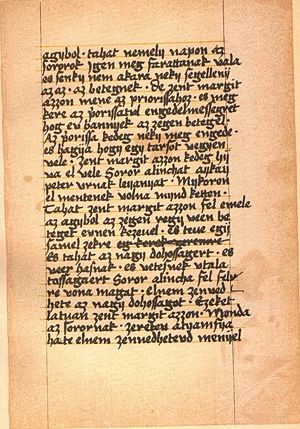
Legend of Saint Margaret
Encyclopedia

Hungarian literature
Hungarian literature is literature written in the Hungarian language, predominantly by Hungarians.There is a limited amount of Old Hungarian literature dating to between the late 12th and the early 16th centuries...
. The only specimen of the text was preserved in the Margaret Codex, copied by Lea Ráskay
Lea Ráskay
Lea Ráskay was a Hungarian Dominican nun living in the monastery of the Hare Island...
in 1510. The legend tells the life and deeds of Saint Margaret of Hungary
Saint Margaret of Hungary
Saint Margaret was a nun and the daughter of King Béla IV and Maria Laskarina. She was the niece of Saint Elizabeth of Hungary and the younger sister of Saint Kinga and Blessed Yolanda.-Early life:...
.
The Margaret Codex
The Margaret Codex is a copy of a lost earlier book. The legend was originally denoted in Latin in the 14th century, and soon was translated to HungarianHungarian language
Hungarian is a Uralic language, part of the Ugric group. With some 14 million speakers, it is one of the most widely spoken non-Indo-European languages in Europe....
. The document was copied in 1510 by the famous early 16th century Hungarian
Hungary
Hungary , officially the Republic of Hungary , is a landlocked country in Central Europe. It is situated in the Carpathian Basin and is bordered by Slovakia to the north, Ukraine and Romania to the east, Serbia and Croatia to the south, Slovenia to the southwest and Austria to the west. The...
nun, Lea Ráskay
Lea Ráskay
Lea Ráskay was a Hungarian Dominican nun living in the monastery of the Hare Island...
. Ráskay is also valued by posterity for saving a number of other Old Hungarian works.
She did not simply copy the book, but also applied her own orthography
Orthography
The orthography of a language specifies a standardized way of using a specific writing system to write the language. Where more than one writing system is used for a language, for example Kurdish, Uyghur, Serbian or Inuktitut, there can be more than one orthography...
, and added several gloss
Gloss
A gloss is a brief notation of the meaning of a word or wording in a text. It may be in the language of the text, or in the reader's language if that is different....
es.
Significance
The legend reveals many less known parts of the life of Saint MargaretSaint Margaret of Hungary
Saint Margaret was a nun and the daughter of King Béla IV and Maria Laskarina. She was the niece of Saint Elizabeth of Hungary and the younger sister of Saint Kinga and Blessed Yolanda.-Early life:...
, and provides a true picture about the lives of the monasteries of Mediaeval Hungary
Hungary
Hungary , officially the Republic of Hungary , is a landlocked country in Central Europe. It is situated in the Carpathian Basin and is bordered by Slovakia to the north, Ukraine and Romania to the east, Serbia and Croatia to the south, Slovenia to the southwest and Austria to the west. The...
. It also gives an insight to the days of Buda
Buda
For detailed information see: History of Buda CastleBuda is the western part of the Hungarian capital Budapest on the west bank of the Danube. The name Buda takes its name from the name of Bleda the Hun ruler, whose name is also Buda in Hungarian.Buda comprises about one-third of Budapest's...
and Pest in the 13th century.
Sample
- HungarianHungarian languageHungarian is a Uralic language, part of the Ugric group. With some 14 million speakers, it is one of the most widely spoken non-Indo-European languages in Europe....
:
- "Nyulak szigetében, másképpen Bódogasszony szigetében, hol nyugoszik Szent Margit asszonynak teste, hogy ott megtudakoznának nagy erős bizonság alatt Szent Margit asszonynak szentséges életéről, csodatételéről, kit ez jámbor doktorok és kananokok híven mind megtőnek és mend végig elvégezék és híven megírák, pápának bevivék, nékönk és írva hagyák, miképpen jól látjátok, az ő legendáját."
- EnglishEnglish languageEnglish is a West Germanic language that arose in the Anglo-Saxon kingdoms of England and spread into what was to become south-east Scotland under the influence of the Anglian medieval kingdom of Northumbria...
:
- English
- "In the Island of the Hares, or in other words, in the island of the Blessed Mary, where the body of the holy lady Margaret reposes, they enquired with being strongly sure about the sacred life and miracles of Saint Margaret, whom these guileless doctors and canons all devotedly testified, verified and faithfully described, and took the text to the popePopeThe Pope is the Bishop of Rome, a position that makes him the leader of the worldwide Catholic Church . In the Catholic Church, the Pope is regarded as the successor of Saint Peter, the Apostle...
, so they, as you can see, left the legend of her to us and in a written form."
Sources
- The text of the legend (in Hungarian only)
- Zolnai Gyula: Nyelvemlékeink a könyvnyomtatás koráig, Budapest, 1894
- Krúdy Gyula: Szent Margit (Available online, in Hungarian)
See also
- Saint Margaret of HungarySaint Margaret of HungarySaint Margaret was a nun and the daughter of King Béla IV and Maria Laskarina. She was the niece of Saint Elizabeth of Hungary and the younger sister of Saint Kinga and Blessed Yolanda.-Early life:...
- Hungarian languageHungarian languageHungarian is a Uralic language, part of the Ugric group. With some 14 million speakers, it is one of the most widely spoken non-Indo-European languages in Europe....
- History of Hungarian

